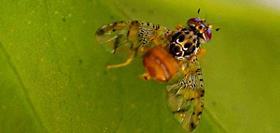
The Australian Pesticides and Veterinary Medicines Authority (APVMA) has published its final report on the use of the fenthion, deciding to phase out the use of the chemical over the next 12 months.
The report took into account submissions from growers, government and representative organisations, assessing the risks and costs associated with the use of fenthion, an insecticide used on apples, avocados, capsicums, tomatoes, stonefruit and other horticultural produce in Australia to control fruit fly.
The APVMA has cancelled the use of fenthion in all horticultural cases from 15 October 2015, citing health and environmental risks, except for post-harvest dipping of tropical and subtropical inedible peel fruits.
The 12-month phase out period is in line with recommendations made by an Australian Senate Inquiry, but some industry groups have cited concerns over a lack of a viable alternative to combat fruit fly outbreaks.
Summer Fruit Australia CEO John Moore said people within the industry were disappointed with the decision.
“Fenthion has been in use for over 40 years and there’s no conclusive evidence that is has been damaging, or could be damaging to health – it’s never been proven,” Moore told Asiafruit. “However, the industry is abiding by the APVMA decisions and we’re thankful for the 12 month continuation before its totally banned.”
The peak industry body was hopeful for a 24-month phase out period to allow growers the opportunity to assess alternative fruit fly treatment – a time frame shared by Apple and Pear Australia chief executive John Dollisson.
“We were hoping for a two year phase out period to help growers adopt different management strategies, to fast-track research and development to find alternative solutions, and to give crop protection companies more time and incentives to develop safe and effective alternatives,” Dollisson said in a company statement.
“We hope that more support from government and the private sector will be forthcoming to help find new products and strategies to help with fruit fly management and control.”
The APVMA has acknowledged the impact that removing fenthion will have on growers, but in a statement provided to Asiafruit, Raj Bhula, executive director of APVMA’s Scientific Assessment and Chemical Review said the industry had been aware of the possible phase out of the pesticide for some three years.
“The impact that the current phase-out of fenthion will have is likely to be variable, with some groups more affected than others over the short-term as they look to adjust to alternative methods of insect control,” Bhula said.
Export impact
A major concern for industry bodies in Australia is that the removal of the use of fenthion could affect export opportunities, particularly for regions susceptible to fruit fly concentrations.
“We have to bear in mind that the presence of fruit fly affects our industry’s capacity to export because a number of target international markets do not accept fruit from areas that have fruit fly,” said Dollisson.
As for the stonefruit industry, Moore is thankful that the majority of Australia’s exported stonefruit is grown in either fruit fly free zones or areas relatively low in pest pressure, such as the Sunraysia and Riverland regions.
“These farmers will be using a combination of methods, whether it be trapping or bait sprays, to combat fruit fly,” Moore said.
Both Dollisson and Moore have acknowledged the use of the Area Wide Management strategy to monitor and control fruit fly, but when it comes to the future of fruit fly management post-fenthion, industry bodies are calling for more research and development in the area, with high costs of registration preventing new chemicals from entering the market.
“The industry will work on,” Moore said. “Now we’ve got limited fruit fly control and it’s going to be up to the growers to utilise the tool box they have at their disposal to handle fruit fly as best they can.”
The APVMA began its review of fenthion in 1998 due to environmental and health concerns associated with its use, opening up submissions to its Preliminary Review Findings Report in May before publishing its final decision on 17 October.



